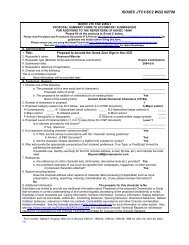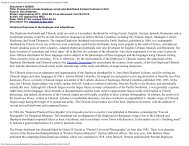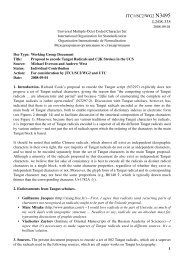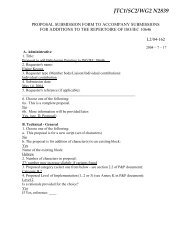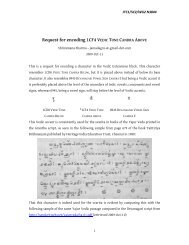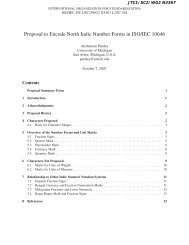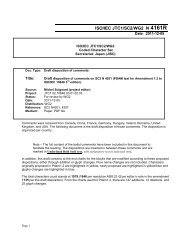Proposal to encode 10 Latin letters for pre-1921 Latvian orthography ...
Proposal to encode 10 Latin letters for pre-1921 Latvian orthography ...
Proposal to encode 10 Latin letters for pre-1921 Latvian orthography ...
You also want an ePaper? Increase the reach of your titles
YUMPU automatically turns print PDFs into web optimized ePapers that Google loves.
Universal Multiple-Octet Coded Character Set<br />
International Organization <strong>for</strong> Standardization<br />
Organisation Internationale de Normalisation<br />
Международная организация по стандартизации<br />
Doc Type: Working Group Document<br />
Title: <strong>Proposal</strong> <strong>to</strong> <strong>encode</strong> <strong>10</strong> <strong>Latin</strong> <strong>letters</strong> <strong>for</strong> <strong>pre</strong>-<strong>1921</strong> <strong>Latvian</strong> <strong>orthography</strong><br />
Source: German NB<br />
Status: National Body Contribution<br />
Action: For consideration by JTC1/SC2/WG2 and UTC<br />
Date: 2009-03-26, revised 2009-04-30 (font <strong>for</strong> re<strong>pre</strong>sentative glyphs changed; note regarding properties added)<br />
Additions <strong>for</strong> <strong>pre</strong>-<strong>1921</strong> <strong>Latvian</strong> <strong>orthography</strong><br />
A U+A7A0 LATIN CAPITAL LETTER G WITH OBLIQUE STROKE<br />
B U+A7A1 LATIN SMALL LETTER G WITH OBLIQUE STROKE<br />
C U+A7A2 LATIN CAPITAL LETTER K WITH OBLIQUE STROKE<br />
D U+A7A3 LATIN SMALL LETTER K WITH OBLIQUE STROKE<br />
E U+A7A4 LATIN CAPITAL LETTER N WITH OBLIQUE STROKE<br />
F U+A7A5 LATIN SMALL LETTER N WITH OBLIQUE STROKE<br />
G U+A7A6 LATIN CAPITAL LETTER R WITH OBLIQUE STROKE<br />
H U+A7A7 LATIN SMALL LETTER R WITH OBLIQUE STROKE<br />
I U+A7A8 LATIN CAPITAL LETTER S WITH OBLIQUE STROKE<br />
· Also used in <strong>pre</strong>-1950 Lower Sorbian <strong>orthography</strong><br />
J U+A7A9 LATIN SMALL LETTER S WITH OBLIQUE STROKE<br />
→ 1E9C latin small letter long s with diagonal stroke<br />
In<strong>for</strong>mative notes and cross references <strong>to</strong> be added <strong>for</strong> existing characters:<br />
U+1E9C LATIN SMALL LETTER LONG S WITH DIAGONAL STROKE<br />
→ A7A9 latin small letter s with oblique stroke<br />
· Medievalist use <strong>for</strong> several abbreviations<br />
· Used in <strong>pre</strong>-<strong>1921</strong> <strong>Latvian</strong> <strong>orthography</strong><br />
· Used in Blackletter types of <strong>pre</strong>-1950 Lower Sorbian <strong>orthography</strong><br />
All these <strong>letters</strong> are used in the <strong>orthography</strong> of Latvia used be<strong>for</strong>e <strong>1921</strong> [4] [5] [7], see fig. 1 <strong>to</strong> 6, 9 <strong>to</strong> 11.<br />
The LATIN SMALL LETTER S WITH OBLIQUE STROKE also occurs in a long s <strong>for</strong>m; this <strong>for</strong>m is unified<br />
with the already <strong>encode</strong>d U+1E9C LATIN SMALL LETTER LONG S WITH DIAGONAL STROKE.<br />
Also, the stroked <strong>for</strong>ms of L/l which are part of the <strong>pre</strong>-<strong>1921</strong> <strong>Latvian</strong> <strong>orthography</strong> are proposed <strong>to</strong> be<br />
unified with the already <strong>encode</strong>d U+0141/0142 LATIN CAPITAL/SMALL LETTER WITH STROKE.<br />
The encoding of the <strong>letters</strong> proposed here closes a gap regarding Blackletter (Fraktur) types:<br />
JTC1/SC2/WG2 N3587R<br />
According <strong>to</strong> [4] (which appeared 1880) pp. 227-234, Blackletter was in common use during the 19th<br />
century <strong>for</strong> the following languages: German, Danish, Swedish, <strong>Latvian</strong>, Finnish, Czech, Slovak.<br />
Even as this list may be incomplete, all <strong>letters</strong> used <strong>for</strong> the 19th century orthographies of all major<br />
European languages are now included in Unicode, with the exception of <strong>Latvian</strong>.<br />
Encoding the <strong>10</strong> <strong>letters</strong> proposed here would enable <strong>to</strong> create Blackletter fonts which cover the<br />
complete 19th century and early 20th century usage in Europe.<br />
The stroked <strong>for</strong>ms of G/g, K/k, L/l, N/n, R/r (but not the stroked <strong>for</strong>m of S/s/ſ) roughly con<strong>for</strong>m <strong>to</strong> the<br />
modern use of cedilla in the modern <strong>Latvian</strong> <strong>orthography</strong> (which is frequently displayed like a comma<br />
below <strong>for</strong> these members, or as a turned comma above in the case of the lowercase g). However, the<br />
stroke cannot be simply regarded as a typographic variant of the modern cedilla, as its appearance is<br />
<strong>Proposal</strong> <strong>to</strong> <strong>encode</strong> <strong>10</strong> <strong>Latin</strong> <strong>letters</strong> <strong>for</strong> <strong>pre</strong>-<strong>1921</strong> <strong>Latvian</strong> <strong>orthography</strong> – 2009-04-30 – Page 1 of <strong>10</strong>
completely different not only in Blackletter (which was the <strong>pre</strong>valent printing type be<strong>for</strong>e <strong>1921</strong> in Latvia),<br />
but also in Roman type (see fig. 1, 9 <strong>to</strong> 11).<br />
Besides the his<strong>to</strong>ric <strong>Latvian</strong> use, the s with oblique stroke also was used in Lower Sorbian <strong>orthography</strong><br />
until about 1950 (until the current <strong>orthography</strong> was introduced) [6]. – See fig. 7 and 8.<br />
Regarding the re<strong>pre</strong>sentative glyphs, the stroke is <strong>pre</strong>sented in a flat angle, according <strong>to</strong> the glyphs<br />
<strong>pre</strong>sented in fig. 1. There<strong>for</strong>e, in the names the term "oblique stroke" is used regarding the stroke.<br />
Properties:<br />
A7A0;LATIN CAPITAL LETTER G WITH OBLIQUE STROKE;Lu;0;L;;;;;N;;;;A7A1;<br />
A7A1;LATIN SMALL LETTER G WITH OBLIQUE STROKE;Ll;0;L;;;;;N;;;A7A0;;A7A0<br />
A7A2;LATIN CAPITAL LETTER K WITH OBLIQUE STROKE;Lu;0;L;;;;;N;;;;A7A3;<br />
A7A3;LATIN SMALL LETTER K WITH OBLIQUE STROKE;Ll;0;L;;;;;N;;;A7A2;;A7A2<br />
A7A4;LATIN CAPITAL LETTER N WITH OBLIQUE STROKE;Lu;0;L;;;;;N;;;;A7A5;<br />
A7A5;LATIN SMALL LETTER N WITH OBLIQUE STROKE;Ll;0;L;;;;;N;;;A7A4;;A7A4<br />
A7A6;LATIN CAPITAL LETTER R WITH OBLIQUE STROKE;Lu;0;L;;;;;N;;;;A7A7;<br />
A7A7;LATIN SMALL LETTER R WITH OBLIQUE STROKE;Ll;0;L;;;;;N;;;A7A6;;A7A6<br />
A7A8;LATIN CAPITAL LETTER S WITH OBLIQUE STROKE;Lu;0;L;;;;;N;;;;A7A9;<br />
A7A9;LATIN SMALL LETTER S WITH OBLIQUE STROKE;Ll;0;L;;;;;N;;;A7A8;;A7A8<br />
Properties <strong>to</strong> be changed <strong>for</strong> already <strong>encode</strong>d <strong>letters</strong>: (reference <strong>to</strong> new uppercase letter)<br />
1E9C;LATIN SMALL LETTER LONG S WITH DIAGONAL STROKE;Ll;0;L;;;;;N;;;A7A8;;A7A8<br />
Note:<br />
The properties (including the case mapping) <strong>for</strong> the triplet I/J/ẜ of the (proposed) U+A7A8/A7A9 and the<br />
already <strong>encode</strong>d U+1E9C were modeled after the already <strong>encode</strong>d triplet Ṡ/ṡ/ẛ U+1E60/1E61/1E9B<br />
(except that the latter triplet shows a canonical decomposition which the proposed one does not):<br />
1E60;LATIN CAPITAL LETTER S WITH DOT ABOVE;Lu;0;L;0053 0307;;;;N;;;;1E61;<br />
1E61;LATIN SMALL LETTER S WITH DOT ABOVE;Ll;0;L;0073 0307;;;;N;;;1E60;;1E60<br />
1E9B;LATIN SMALL LETTER LONG S WITH DOT ABOVE;Ll;0;L;017F 0307;;;;N;;;1E60;;1E60<br />
They resemble also the triplet S/s/ſ (except that this employs a compatibility equivalence <strong>for</strong> the long s;<br />
however, adding an equivalent compatibility equivalence <strong>for</strong> the already <strong>encode</strong>d U+1E9C <strong>to</strong> the<br />
proposed U+A7A9 was not considered <strong>for</strong> several reasons, like the use of U+1E9C in medieval context<br />
where it has a distinctive meaning):<br />
0053;LATIN CAPITAL LETTER S;Lu;0;L;;;;;N;;;;0073;<br />
0073;LATIN SMALL LETTER S;Ll;0;L;;;;;N;;;0053;;0053<br />
017F;LATIN SMALL LETTER LONG S;Ll;0;L; 0073;;;;N;;;0053;;0053<br />
<strong>Proposal</strong> <strong>to</strong> <strong>encode</strong> <strong>10</strong> <strong>Latin</strong> <strong>letters</strong> <strong>for</strong> <strong>pre</strong>-<strong>1921</strong> <strong>Latvian</strong> <strong>orthography</strong> – 2009-04-30 – Page 2 of <strong>10</strong>
Bibliography:<br />
[1] ALLEN, C. G.: A Manual of European Languages <strong>for</strong> Librarians.<br />
London & New York 1981, ISBN 0-85935-028-2<br />
[2] BEZZENBERGER, Adalbert: Lettische Dialekt-Studien. Göttingen 1885<br />
[3] BIELENSTEIN, A: Lettische Grammatik. Mitau 1863<br />
[4] FAULMANN, Carl: Das Buch der Schrift.<br />
Wien 1880. Reprint Nördlingen 1985, ISBN 392156851X<br />
[5] HELLWIG, Wilhelm: Der Satz und die Behandlung fremder Sprachen. 5th. ed., Frankfurt/M. 1930<br />
[6] KAULFÜRST, Fabian (Sorbisches Institut / Serbski Institut, Bautzen/Budyšin, Germany):<br />
personal communication 2005/2008/2009.<br />
[7] REICHSDRUCKEREI: Alphabete und Schriftzeichen des Morgen- und des Abendlandes. Berlin 1924.<br />
[8] WISCHMANN, Johann: Der Unteutsche Opitz. Oder Kurtze Anleitung zur Lettischen Dicht⸗Kunst.<br />
(The Not-German [i.e. <strong>Latvian</strong>] Opitz. Or, Short Guidance <strong>to</strong> the <strong>Latvian</strong> Art of Poetry.)<br />
Rīga 1697<br />
[9] Agenda. sa tu evangelisku zerkwu we Pschuskej. Worjejce (Hoyerswerda; Germany), 1898.<br />
[<strong>10</strong>] Skohlas-Likkumi. Rīga 1789.<br />
Acknowledgements:<br />
The proposal was mainly compiled by Karl Pentzlin.<br />
Special thanks <strong>for</strong> valuable in<strong>for</strong>mation <strong>to</strong>:<br />
Fabian Kaulfürst (Sorbisches Institut / Serbski Institut [Sorbian Institute], Bautzen/Budyšin, Germany)<br />
Prof. Stefan Kessler (Institut für Fremdsprachliche Philologien / Baltistik der Universität Greifswald, Germany)<br />
Gunars Lucans<br />
Sonja Pentzlin<br />
Andreas Stötzner (Signographisches Institut Andreas Stötzner, Pegau/Sa., Germany) <strong>for</strong> some of the<br />
samples, <strong>for</strong> a thorough discussion, and <strong>for</strong> providing the font used <strong>for</strong> the re<strong>pre</strong>sentative glyphs<br />
and all members of the Unicode mailing list who participated in the discussion of earlier drafts.<br />
<strong>Proposal</strong> <strong>to</strong> <strong>encode</strong> <strong>10</strong> <strong>Latin</strong> <strong>letters</strong> <strong>for</strong> <strong>pre</strong>-<strong>1921</strong> <strong>Latvian</strong> <strong>orthography</strong> – 2009-04-30 – Page 3 of <strong>10</strong>
Fig. 1: Scan from [4], p. 231, listing all <strong>letters</strong> of the <strong>Latvian</strong> <strong>orthography</strong> valid at its date of original print<br />
(1880), including all <strong>letters</strong> proposed here (the LATIN SMALL LETTER S WITH OBLIQUE<br />
STROKE is found in its round <strong>for</strong>m in the "Fraktur" (Blackletter) column).<br />
Fig. 2: Scan from [7], p. 76, showing the small letter<strong>for</strong>ms and documenting the date until the old <strong>Latvian</strong><br />
<strong>orthography</strong> was valid (starting in the sixth line of the right column, translating "Since <strong>1921</strong>, a new<br />
<strong>orthography</strong> is introduced ...") – Scan and reference provided by Andreas Stötzner, Signographisches Institut<br />
<strong>Proposal</strong> <strong>to</strong> <strong>encode</strong> <strong>10</strong> <strong>Latin</strong> <strong>letters</strong> <strong>for</strong> <strong>pre</strong>-<strong>1921</strong> <strong>Latvian</strong> <strong>orthography</strong> – 2009-04-30 – Page 4 of <strong>10</strong>
Fig. 3: Scan from [5], p. 186, showing the small letter<strong>for</strong>ms in the table and the capital <strong>for</strong>ms in the text<br />
(last line). – Scan and reference provided by Andreas Stötzner, Signographisches Institut<br />
<strong>Proposal</strong> <strong>to</strong> <strong>encode</strong> <strong>10</strong> <strong>Latin</strong> <strong>letters</strong> <strong>for</strong> <strong>pre</strong>-<strong>1921</strong> <strong>Latvian</strong> <strong>orthography</strong> – 2009-04-30 – Page 5 of <strong>10</strong>
Fig. 4: Scan from [8], p.19, showing all lower case <strong>for</strong>ms of the proposed <strong>letters</strong>.<br />
The Text is in German, discussing rhyming rules <strong>for</strong> <strong>Latvian</strong>. The sentence containing the letter<br />
series translates: "You also may rhyme the soft [<strong>letters</strong>] with their hard [counterparts], and the<br />
slashed g,k,l,n,r,s,sch with g,k,l,n,r,s,sch, if only this happens not <strong>to</strong>o often and without necessity."<br />
– Scan and reference provided by Prof. Stefan Kessler, Universität Greifswald<br />
Fig. 5: Scan from [<strong>10</strong>], p.12, showing some of the proposed <strong>letters</strong>.<br />
Retrieved from http://valoda.ailab.lv/korpuss/senie/faksimili/18gs/SL1789/0012a.htm, 2008-<strong>10</strong>-28.<br />
Note: This example shows ligatures of two long s with stroke (line starting with "2.") and of two l<br />
with stroke (second last line), employing a common stroke between the two <strong>letters</strong>. Such ligatures<br />
are common in 18th century prints but we have found no such ligatures in 19th century prints. We<br />
regard such ligatures as <strong>pre</strong>sentation <strong>for</strong>ms, like other common Blackletter ligatures like "ch".<br />
– Reference provided by Gunars Lucans<br />
<strong>Proposal</strong> <strong>to</strong> <strong>encode</strong> <strong>10</strong> <strong>Latin</strong> <strong>letters</strong> <strong>for</strong> <strong>pre</strong>-<strong>1921</strong> <strong>Latvian</strong> <strong>orthography</strong> – 2009-04-30 – Page 6 of <strong>10</strong>
Fig. 6: Scan from [1], p.595, showing a sample text of <strong>Latvian</strong> (set in Fraktur), showing some of the<br />
proposed <strong>letters</strong>.<br />
Fig. 7: Scan from a Lower Sorbian text of 1905.<br />
As this text is set in Blackletter, it shows the s with oblique stroke in its long <strong>for</strong>m only.<br />
– Scan provided by Fabian Kaulfürst<br />
Fig. 8: Scan from [9], providing a Lower Sorbian example from 1898, showing also the upper case of the<br />
S with oblique stroke. – Scan and reference provided by Fabian Kaulfürst<br />
<strong>Proposal</strong> <strong>to</strong> <strong>encode</strong> <strong>10</strong> <strong>Latin</strong> <strong>letters</strong> <strong>for</strong> <strong>pre</strong>-<strong>1921</strong> <strong>Latvian</strong> <strong>orthography</strong> – 2009-04-30 – Page 7 of <strong>10</strong>
Fig. 9: Scan from [2] (p.48), providing a <strong>Latvian</strong> example showing some of the proposed <strong>letters</strong>,<br />
printed in Antiqua type.<br />
Fig. <strong>10</strong>: Another scan from [2] (p.48), providing a <strong>Latvian</strong> example showing some of the proposed<br />
<strong>letters</strong>, printed in Antiqua type.<br />
Fig. 11: Scan from [3] (a <strong>Latvian</strong> grammar in German), showing <strong>Latvian</strong> examples in Antiqua type.<br />
<strong>Proposal</strong> <strong>to</strong> <strong>encode</strong> <strong>10</strong> <strong>Latin</strong> <strong>letters</strong> <strong>for</strong> <strong>pre</strong>-<strong>1921</strong> <strong>Latvian</strong> <strong>orthography</strong> – 2009-04-30 – Page 8 of <strong>10</strong>
ISO/IEC JTC 1/SC 2/WG 2<br />
PROPOSAL SUMMARY FORM TO ACCOMPANY SUBMISSIONS<br />
FOR ADDITIONS TO THE REPERTOIRE OF ISO/IEC <strong>10</strong>646T P<br />
Please fill all the sections A, B and C below.<br />
guidelines<br />
and details be<strong>for</strong>e filling this <strong>for</strong>m.<br />
Uhttp://www.dkuug.dk/JTC1/SC2/WG2/docs/summary<strong>for</strong>m.htmlUTH.<br />
TH<br />
<strong>for</strong> latest Roadmaps.<br />
Please read Principles and Procedures Document (P & P) from HT<br />
Uhttp://www.dkuug.dk/JTC1/SC2/WG2/docs/principles.html UTH<br />
<strong>for</strong><br />
A. Administrative<br />
Please ensure you are using the latest Form from HT<br />
See also HTUhttp://www.dkuug.dk/JTC1/SC2/WG2/docs/roadmaps.html<br />
U<br />
1. Title: <strong>Proposal</strong> <strong>to</strong> <strong>encode</strong> <strong>10</strong> <strong>Latin</strong> <strong>letters</strong> <strong>for</strong> <strong>pre</strong>-<strong>1921</strong> <strong>Latvian</strong> <strong>orthography</strong><br />
2. Requester's name: German NB<br />
3. Requester type (Member body/Liaison/Individual contribution): Member Body Contribution<br />
4. Submission date: 2009-03-26, revised 2009-04-30<br />
5. Requester's reference (if applicable):<br />
6. Choose one of the following:<br />
This is a complete proposal: Yes<br />
(or) More in<strong>for</strong>mation will be provided later:<br />
B. Technical – General<br />
1. Choose one of the following:<br />
a. This proposal is <strong>for</strong> a new script (set of characters): No<br />
Proposed name of script:<br />
b. The proposal is <strong>for</strong> addition of character(s) <strong>to</strong> an existing block: Yes<br />
Name of the existing block: <strong>Latin</strong> Extended-D<br />
2. Number of characters in proposal: <strong>10</strong><br />
3. Proposed category (select one from below - see section 2.2 of P&P document):<br />
A-Contemporary B.1-Specialized (small collection) X B.2-Specialized (large collection)<br />
C-Major extinct D-Attested extinct E-Minor extinct<br />
F-Archaic Hieroglyphic or Ideographic G-Obscure or questionable usage symbols<br />
4. Is a reper<strong>to</strong>ire including character names provided? Yes<br />
a. If YES, are the names in accordance with the “character naming guidelines”<br />
in Annex L of P&P document? Yes<br />
b. Are the character shapes attached in a legible <strong>for</strong>m suitable <strong>for</strong> review? Yes<br />
5. Who will provide the appropriate computerized font (ordered <strong>pre</strong>ference: True Type, or PostScript <strong>for</strong>mat) <strong>for</strong><br />
publishing the standard? Andreas Stötzner (Signographisches Institut, Pegau/Sa., Germany)<br />
If available now, identify source(s) <strong>for</strong> the font (include address, e-mail, ftp-site, etc.) and indicate the <strong>to</strong>ols<br />
used: http://www.pentzlin.com/AndronLettischglyphen.zip (containing the font as .TTF file)<br />
6. References:<br />
a. Are references (<strong>to</strong> other character sets, dictionaries, descriptive texts etc.) provided? Yes<br />
b. Are published examples of use (such as samples from newspapers, magazines, or other sources)<br />
of proposed characters attached? Yes<br />
7. Special encoding issues:<br />
Does the proposal address other aspects of character data processing (if applicable) such as input,<br />
<strong>pre</strong>sentation, sorting, searching, indexing, transliteration etc. (if yes please enclose in<strong>for</strong>mation)? No<br />
8. Additional In<strong>for</strong>mation:<br />
Submitters are invited <strong>to</strong> provide any additional in<strong>for</strong>mation about Properties of the proposed Character(s) or Script<br />
that will assist in correct understanding of and correct linguistic processing of the proposed character(s) or script.<br />
Examples of such properties are: Casing in<strong>for</strong>mation, Numeric in<strong>for</strong>mation, Currency in<strong>for</strong>mation, Display behaviour<br />
in<strong>for</strong>mation such as line breaks, widths etc., Combining behaviour, Spacing behaviour, Directional behaviour, Default<br />
Collation behaviour, relevance in Mark Up contexts, Compatibility equivalence and other Unicode normalization<br />
related in<strong>for</strong>mation. See the Unicode standard at HT<br />
Uhttp://www.unicode.orgUTH<br />
<strong>for</strong> such in<strong>for</strong>mation on other scripts. Also<br />
see H TUhttp://www.unicode.org/Public/UNIDATA/UCD.htmlUTH<br />
and associated Unicode Technical Reports <strong>for</strong> in<strong>for</strong>mation<br />
needed <strong>for</strong> consideration by the Unicode Technical Committee <strong>for</strong> inclusion in the Unicode Standard.<br />
1<br />
TP<br />
PT<br />
Form number: N3152-F (Original 1994-<strong>10</strong>-14; Revised 1995-01, 1995-04, 1996-04, 1996-08, 1999-03, 2001-05, 2001-09, 2003-11, 2005-01,<br />
2005-09, 2005-<strong>10</strong>, 2007-03, 2008-05)<br />
<strong>Proposal</strong> <strong>to</strong> <strong>encode</strong> <strong>10</strong> <strong>Latin</strong> <strong>letters</strong> <strong>for</strong> <strong>pre</strong>-<strong>1921</strong> <strong>Latvian</strong> <strong>orthography</strong> – 2009-04-30 – Page 9 of <strong>10</strong><br />
1<br />
PT
C. Technical - Justification<br />
1. Has this proposal <strong>for</strong> addition of character(s) been submitted be<strong>for</strong>e? No<br />
If YES explain (This proposal is a rework of L2/08-405 which was not decided at UTC #117 of Nov. 2008)<br />
2. Has contact been made <strong>to</strong> members of the user community (<strong>for</strong> example: National Body,<br />
user groups of the script or characters, other experts, etc.)? Yes<br />
If YES, with whom? see references in the text<br />
If YES, available relevant documents: see references in the text<br />
3. In<strong>for</strong>mation on the user community <strong>for</strong> the proposed characters (<strong>for</strong> example:<br />
size, demographics, in<strong>for</strong>mation technology use, or publishing use) is included? Yes<br />
Reference: see text<br />
4. The context of use <strong>for</strong> the proposed characters (type of use; common or rare) see text<br />
Reference: see text<br />
5. Are the proposed characters in current use by the user community? Yes<br />
If YES, where? Reference: see text<br />
6. After giving due considerations <strong>to</strong> the principles in the P&P document must the proposed characters be entirely<br />
in the BMP? Yes<br />
If YES, is a rationale provided? Yes<br />
If YES, reference: Keeping in line with other <strong>Latin</strong> characters<br />
7. Should the proposed characters be kept <strong>to</strong>gether in a contiguous range (rather than being scattered)? Preferred<br />
8. Can any of the proposed characters be considered a <strong>pre</strong>sentation <strong>for</strong>m of an existing<br />
character or character sequence? No<br />
If YES, is a rationale <strong>for</strong> its inclusion provided?<br />
If YES, reference:<br />
9. Can any of the proposed characters be <strong>encode</strong>d using a composed character sequence of either<br />
existing characters or other proposed characters? No<br />
If YES, is a rationale <strong>for</strong> its inclusion provided?<br />
If YES, reference:<br />
<strong>10</strong>. Can any of the proposed character(s) be considered <strong>to</strong> be similar (in appearance or function)<br />
<strong>to</strong> an existing character? No<br />
If YES, is a rationale <strong>for</strong> its inclusion provided?<br />
If YES, reference:<br />
11. Does the proposal include use of combining characters and/or use of composite sequences? No<br />
If YES, is a rationale <strong>for</strong> such use provided?<br />
If YES, reference:<br />
Is a list of composite sequences and their corresponding glyph images (graphic symbols) provided? n/a<br />
If YES, reference:<br />
12. Does the proposal contain characters with any special properties such as<br />
control function or similar semantics? No<br />
If YES, describe in detail (include attachment if necessary)<br />
13. Does the proposal contain any Ideographic compatibility character(s)? No<br />
If YES, is the equivalent corresponding unified ideographic character(s) identified?<br />
If YES, reference:<br />
<strong>Proposal</strong> <strong>to</strong> <strong>encode</strong> <strong>10</strong> <strong>Latin</strong> <strong>letters</strong> <strong>for</strong> <strong>pre</strong>-<strong>1921</strong> <strong>Latvian</strong> <strong>orthography</strong> – 2009-04-30 – Page <strong>10</strong> of <strong>10</strong>



